Study Skills for Higher Education
VerifiedAdded on 2023/02/02
|12
|2710
|66
AI Summary
This project focuses on study skills for higher education, specifically on time management skills and critical thinking skills. It includes an individual essay assignment on Hofstede's cultural dimensions and an individual report on corporate social responsibility. The project aims to develop students' ability to analyze and interpret information, apply critical thinking skills, and gather valuable information for research.
Contribute Materials
Your contribution can guide someone’s learning journey. Share your
documents today.
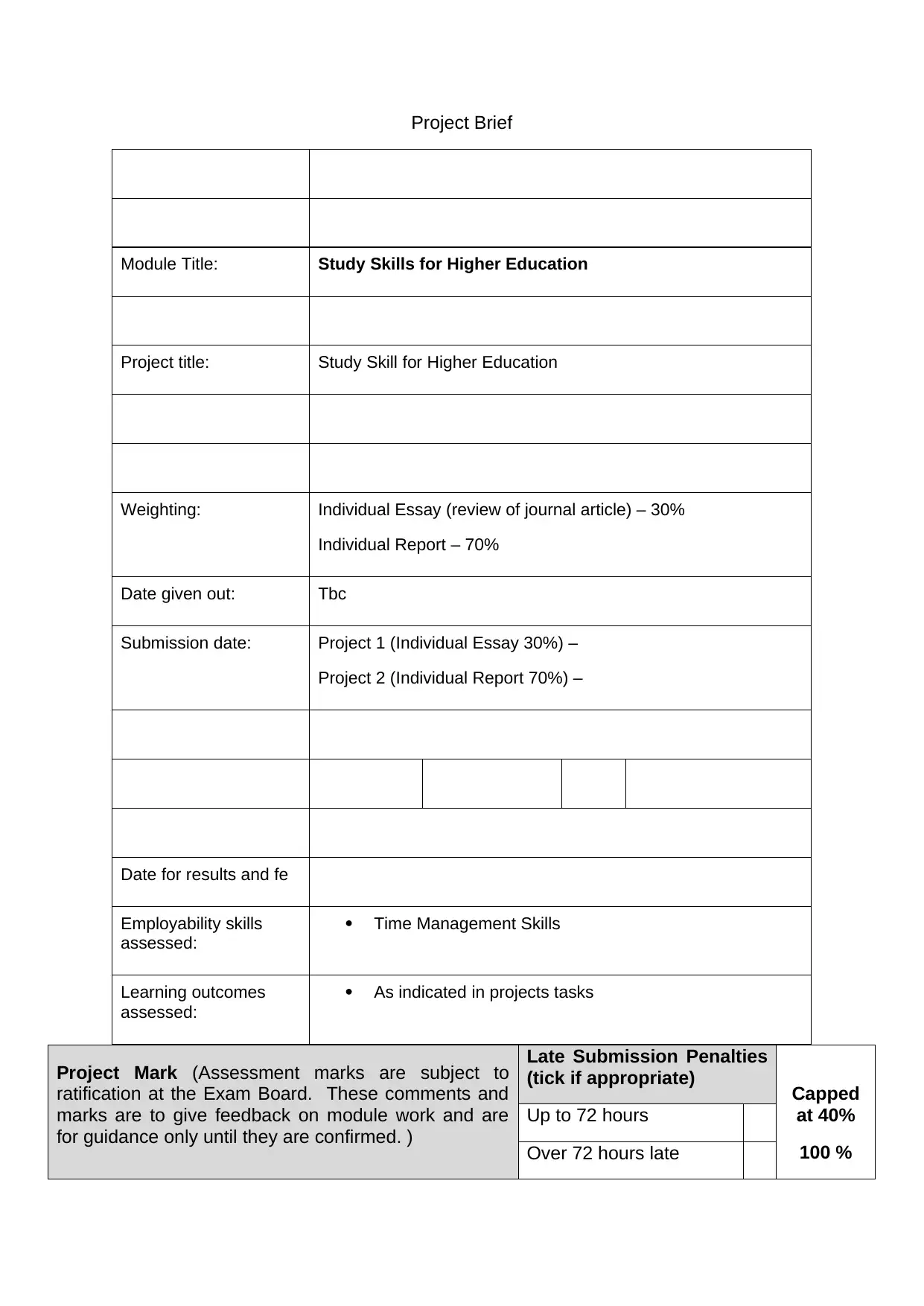
Project Brief
Module Title: Study Skills for Higher Education
Project title: Study Skill for Higher Education
Weighting: Individual Essay (review of journal article) – 30%
Individual Report – 70%
Date given out: Tbc
Submission date: Project 1 (Individual Essay 30%) –
Project 2 (Individual Report 70%) –
Date for results and fe
Employability skills
assessed:
Time Management Skills
Learning outcomes
assessed:
As indicated in projects tasks
Project Mark (Assessment marks are subject to
ratification at the Exam Board. These comments and
marks are to give feedback on module work and are
for guidance only until they are confirmed. )
Late Submission Penalties
(tick if appropriate) Capped
at 40%
100 %
Up to 72 hours
Over 72 hours late
Module Title: Study Skills for Higher Education
Project title: Study Skill for Higher Education
Weighting: Individual Essay (review of journal article) – 30%
Individual Report – 70%
Date given out: Tbc
Submission date: Project 1 (Individual Essay 30%) –
Project 2 (Individual Report 70%) –
Date for results and fe
Employability skills
assessed:
Time Management Skills
Learning outcomes
assessed:
As indicated in projects tasks
Project Mark (Assessment marks are subject to
ratification at the Exam Board. These comments and
marks are to give feedback on module work and are
for guidance only until they are confirmed. )
Late Submission Penalties
(tick if appropriate) Capped
at 40%
100 %
Up to 72 hours
Over 72 hours late
Secure Best Marks with AI Grader
Need help grading? Try our AI Grader for instant feedback on your assignments.

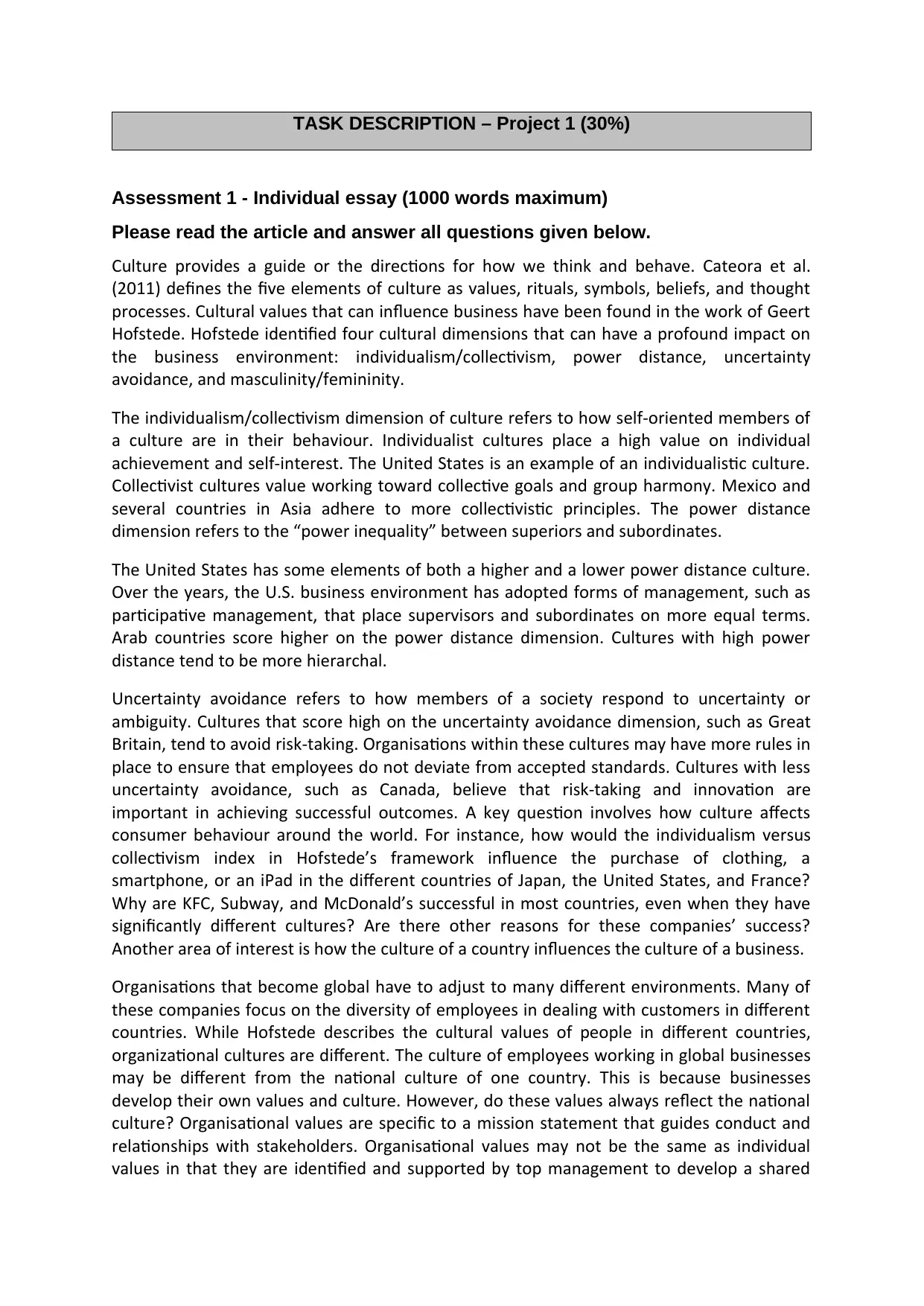
TASK DESCRIPTION – Project 1 (30%)
Assessment 1 - Individual essay (1000 words maximum)
Please read the article and answer all questions given below.
Culture provides a guide or the directions for how we think and behave. Cateora et al.
(2011) defines the five elements of culture as values, rituals, symbols, beliefs, and thought
processes. Cultural values that can influence business have been found in the work of Geert
Hofstede. Hofstede identified four cultural dimensions that can have a profound impact on
the business environment: individualism/collectivism, power distance, uncertainty
avoidance, and masculinity/femininity.
The individualism/collectivism dimension of culture refers to how self-oriented members of
a culture are in their behaviour. Individualist cultures place a high value on individual
achievement and self-interest. The United States is an example of an individualistic culture.
Collectivist cultures value working toward collective goals and group harmony. Mexico and
several countries in Asia adhere to more collectivistic principles. The power distance
dimension refers to the “power inequality” between superiors and subordinates.
The United States has some elements of both a higher and a lower power distance culture.
Over the years, the U.S. business environment has adopted forms of management, such as
participative management, that place supervisors and subordinates on more equal terms.
Arab countries score higher on the power distance dimension. Cultures with high power
distance tend to be more hierarchal.
Uncertainty avoidance refers to how members of a society respond to uncertainty or
ambiguity. Cultures that score high on the uncertainty avoidance dimension, such as Great
Britain, tend to avoid risk-taking. Organisations within these cultures may have more rules in
place to ensure that employees do not deviate from accepted standards. Cultures with less
uncertainty avoidance, such as Canada, believe that risk-taking and innovation are
important in achieving successful outcomes. A key question involves how culture affects
consumer behaviour around the world. For instance, how would the individualism versus
collectivism index in Hofstede’s framework influence the purchase of clothing, a
smartphone, or an iPad in the different countries of Japan, the United States, and France?
Why are KFC, Subway, and McDonald’s successful in most countries, even when they have
significantly different cultures? Are there other reasons for these companies’ success?
Another area of interest is how the culture of a country influences the culture of a business.
Organisations that become global have to adjust to many different environments. Many of
these companies focus on the diversity of employees in dealing with customers in different
countries. While Hofstede describes the cultural values of people in different countries,
organizational cultures are different. The culture of employees working in global businesses
may be different from the national culture of one country. This is because businesses
develop their own values and culture. However, do these values always reflect the national
culture? Organisational values are specific to a mission statement that guides conduct and
relationships with stakeholders. Organisational values may not be the same as individual
values in that they are identified and supported by top management to develop a shared
Assessment 1 - Individual essay (1000 words maximum)
Please read the article and answer all questions given below.
Culture provides a guide or the directions for how we think and behave. Cateora et al.
(2011) defines the five elements of culture as values, rituals, symbols, beliefs, and thought
processes. Cultural values that can influence business have been found in the work of Geert
Hofstede. Hofstede identified four cultural dimensions that can have a profound impact on
the business environment: individualism/collectivism, power distance, uncertainty
avoidance, and masculinity/femininity.
The individualism/collectivism dimension of culture refers to how self-oriented members of
a culture are in their behaviour. Individualist cultures place a high value on individual
achievement and self-interest. The United States is an example of an individualistic culture.
Collectivist cultures value working toward collective goals and group harmony. Mexico and
several countries in Asia adhere to more collectivistic principles. The power distance
dimension refers to the “power inequality” between superiors and subordinates.
The United States has some elements of both a higher and a lower power distance culture.
Over the years, the U.S. business environment has adopted forms of management, such as
participative management, that place supervisors and subordinates on more equal terms.
Arab countries score higher on the power distance dimension. Cultures with high power
distance tend to be more hierarchal.
Uncertainty avoidance refers to how members of a society respond to uncertainty or
ambiguity. Cultures that score high on the uncertainty avoidance dimension, such as Great
Britain, tend to avoid risk-taking. Organisations within these cultures may have more rules in
place to ensure that employees do not deviate from accepted standards. Cultures with less
uncertainty avoidance, such as Canada, believe that risk-taking and innovation are
important in achieving successful outcomes. A key question involves how culture affects
consumer behaviour around the world. For instance, how would the individualism versus
collectivism index in Hofstede’s framework influence the purchase of clothing, a
smartphone, or an iPad in the different countries of Japan, the United States, and France?
Why are KFC, Subway, and McDonald’s successful in most countries, even when they have
significantly different cultures? Are there other reasons for these companies’ success?
Another area of interest is how the culture of a country influences the culture of a business.
Organisations that become global have to adjust to many different environments. Many of
these companies focus on the diversity of employees in dealing with customers in different
countries. While Hofstede describes the cultural values of people in different countries,
organizational cultures are different. The culture of employees working in global businesses
may be different from the national culture of one country. This is because businesses
develop their own values and culture. However, do these values always reflect the national
culture? Organisational values are specific to a mission statement that guides conduct and
relationships with stakeholders. Organisational values may not be the same as individual
values in that they are identified and supported by top management to develop a shared
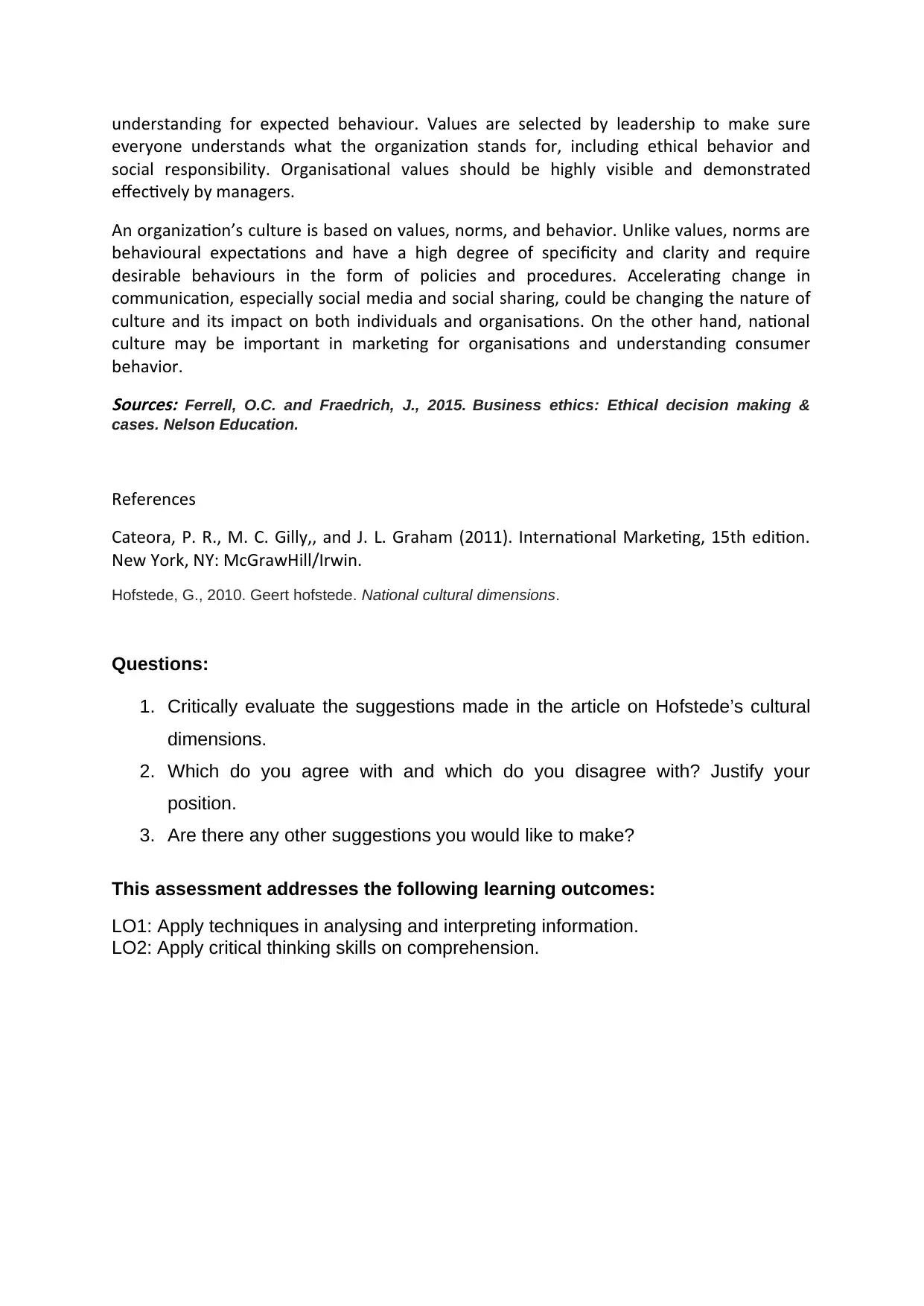
understanding for expected behaviour. Values are selected by leadership to make sure
everyone understands what the organization stands for, including ethical behavior and
social responsibility. Organisational values should be highly visible and demonstrated
effectively by managers.
An organization’s culture is based on values, norms, and behavior. Unlike values, norms are
behavioural expectations and have a high degree of specificity and clarity and require
desirable behaviours in the form of policies and procedures. Accelerating change in
communication, especially social media and social sharing, could be changing the nature of
culture and its impact on both individuals and organisations. On the other hand, national
culture may be important in marketing for organisations and understanding consumer
behavior.Sources: Ferrell, O.C. and Fraedrich, J., 2015. Business ethics: Ethical decision making &
cases. Nelson Education.
References
Cateora, P. R., M. C. Gilly,, and J. L. Graham (2011). International Marketing, 15th edition.
New York, NY: McGrawHill/Irwin.
Hofstede, G., 2010. Geert hofstede. National cultural dimensions.
Questions:
1. Critically evaluate the suggestions made in the article on Hofstede’s cultural
dimensions.
2. Which do you agree with and which do you disagree with? Justify your
position.
3. Are there any other suggestions you would like to make?
This assessment addresses the following learning outcomes:
LO1: Apply techniques in analysing and interpreting information.
LO2: Apply critical thinking skills on comprehension.
everyone understands what the organization stands for, including ethical behavior and
social responsibility. Organisational values should be highly visible and demonstrated
effectively by managers.
An organization’s culture is based on values, norms, and behavior. Unlike values, norms are
behavioural expectations and have a high degree of specificity and clarity and require
desirable behaviours in the form of policies and procedures. Accelerating change in
communication, especially social media and social sharing, could be changing the nature of
culture and its impact on both individuals and organisations. On the other hand, national
culture may be important in marketing for organisations and understanding consumer
behavior.Sources: Ferrell, O.C. and Fraedrich, J., 2015. Business ethics: Ethical decision making &
cases. Nelson Education.
References
Cateora, P. R., M. C. Gilly,, and J. L. Graham (2011). International Marketing, 15th edition.
New York, NY: McGrawHill/Irwin.
Hofstede, G., 2010. Geert hofstede. National cultural dimensions.
Questions:
1. Critically evaluate the suggestions made in the article on Hofstede’s cultural
dimensions.
2. Which do you agree with and which do you disagree with? Justify your
position.
3. Are there any other suggestions you would like to make?
This assessment addresses the following learning outcomes:
LO1: Apply techniques in analysing and interpreting information.
LO2: Apply critical thinking skills on comprehension.
Secure Best Marks with AI Grader
Need help grading? Try our AI Grader for instant feedback on your assignments.
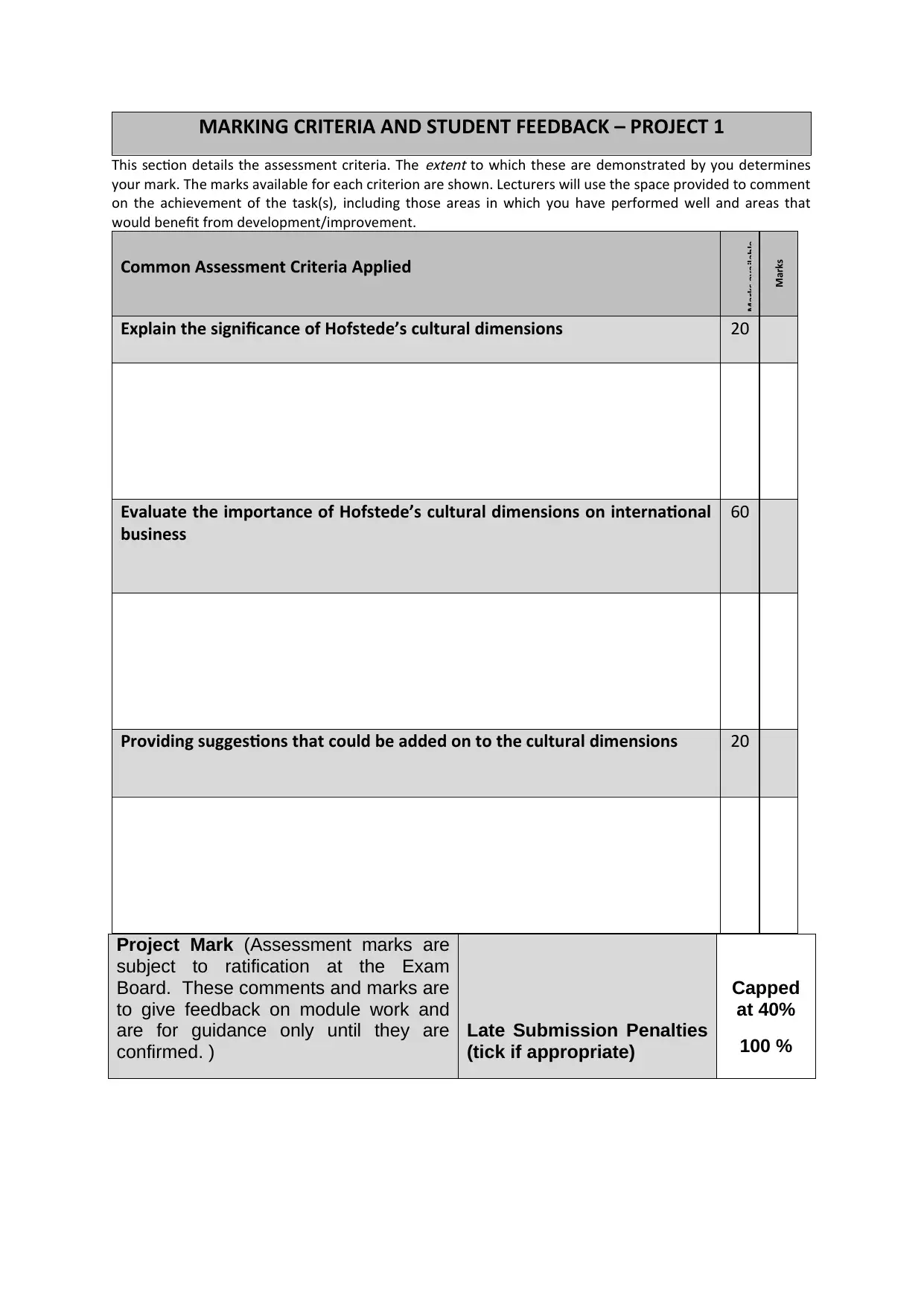
MARKING CRITERIA AND STUDENT FEEDBACK – PROJECT 1
This section details the assessment criteria. The
extent to which these are demonstrated by you determines
your mark. The marks available for each criterion are shown. Lecturers will use the space provided to comment
on the achievement of the task(s), including those areas in which you have performed well and areas that
would benefit from development/improvement.
Common Assessment Criteria Applied
Marks available
Marks
Explain the significance of Hofstede’s cultural dimensions 20
Evaluate the importance of Hofstede’s cultural dimensions on international
business
60
Providing suggestions that could be added on to the cultural dimensions 20
Project Mark (Assessment marks are
subject to ratification at the Exam
Board. These comments and marks are
to give feedback on module work and
are for guidance only until they are
confirmed. )
Late Submission Penalties
(tick if appropriate)
Capped
at 40%
100 %
This section details the assessment criteria. The
extent to which these are demonstrated by you determines
your mark. The marks available for each criterion are shown. Lecturers will use the space provided to comment
on the achievement of the task(s), including those areas in which you have performed well and areas that
would benefit from development/improvement.
Common Assessment Criteria Applied
Marks available
Marks
Explain the significance of Hofstede’s cultural dimensions 20
Evaluate the importance of Hofstede’s cultural dimensions on international
business
60
Providing suggestions that could be added on to the cultural dimensions 20
Project Mark (Assessment marks are
subject to ratification at the Exam
Board. These comments and marks are
to give feedback on module work and
are for guidance only until they are
confirmed. )
Late Submission Penalties
(tick if appropriate)
Capped
at 40%
100 %
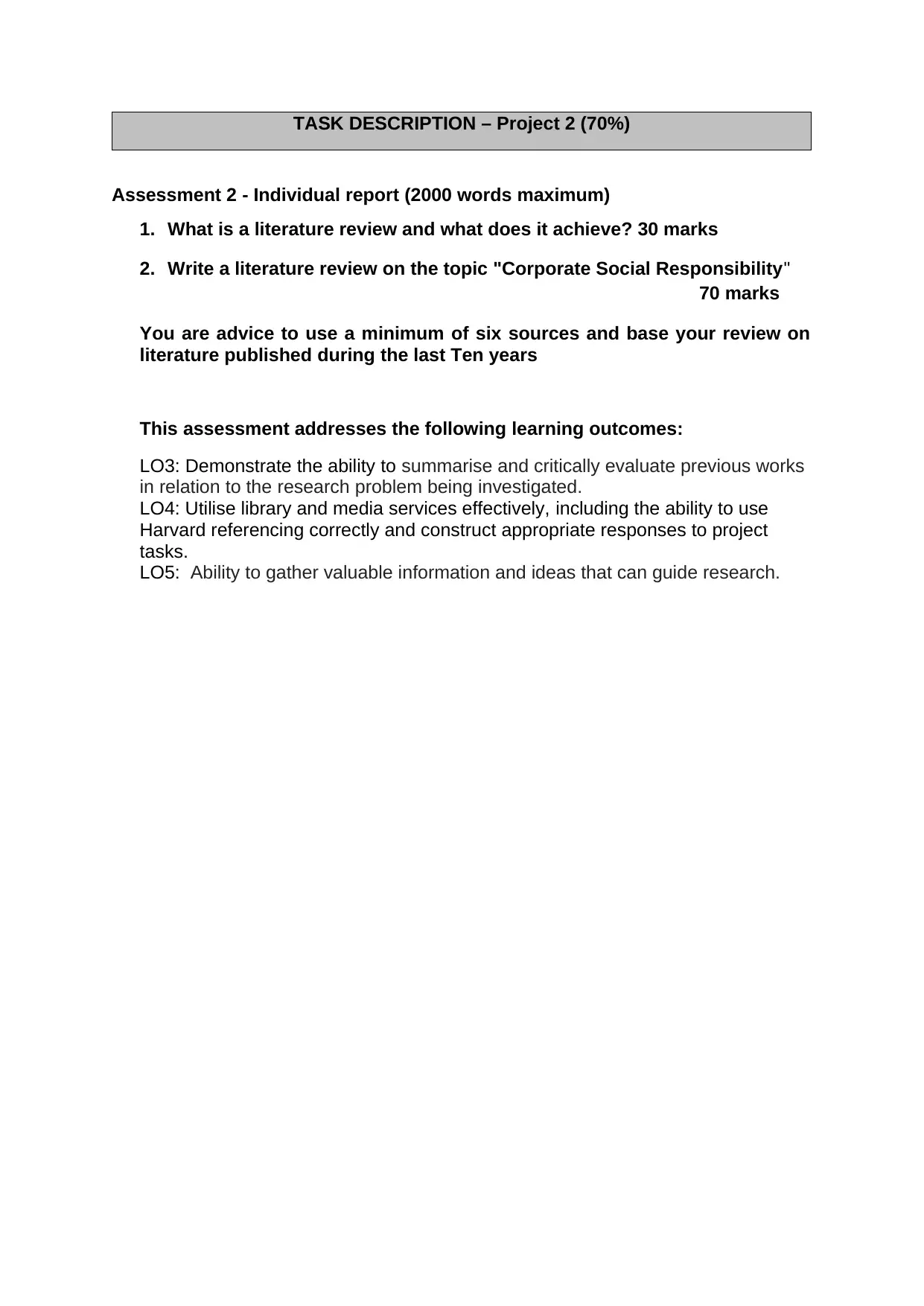
TASK DESCRIPTION – Project 2 (70%)
Assessment 2 - Individual report (2000 words maximum)
1. What is a literature review and what does it achieve? 30 marks
2. Write a literature review on the topic "Corporate Social Responsibility"
70 marks
You are advice to use a minimum of six sources and base your review on
literature published during the last Ten years
This assessment addresses the following learning outcomes:
LO3: Demonstrate the ability to summarise and critically evaluate previous works
in relation to the research problem being investigated.
LO4: Utilise library and media services effectively, including the ability to use
Harvard referencing correctly and construct appropriate responses to project
tasks.
LO5: Ability to gather valuable information and ideas that can guide research.
Assessment 2 - Individual report (2000 words maximum)
1. What is a literature review and what does it achieve? 30 marks
2. Write a literature review on the topic "Corporate Social Responsibility"
70 marks
You are advice to use a minimum of six sources and base your review on
literature published during the last Ten years
This assessment addresses the following learning outcomes:
LO3: Demonstrate the ability to summarise and critically evaluate previous works
in relation to the research problem being investigated.
LO4: Utilise library and media services effectively, including the ability to use
Harvard referencing correctly and construct appropriate responses to project
tasks.
LO5: Ability to gather valuable information and ideas that can guide research.
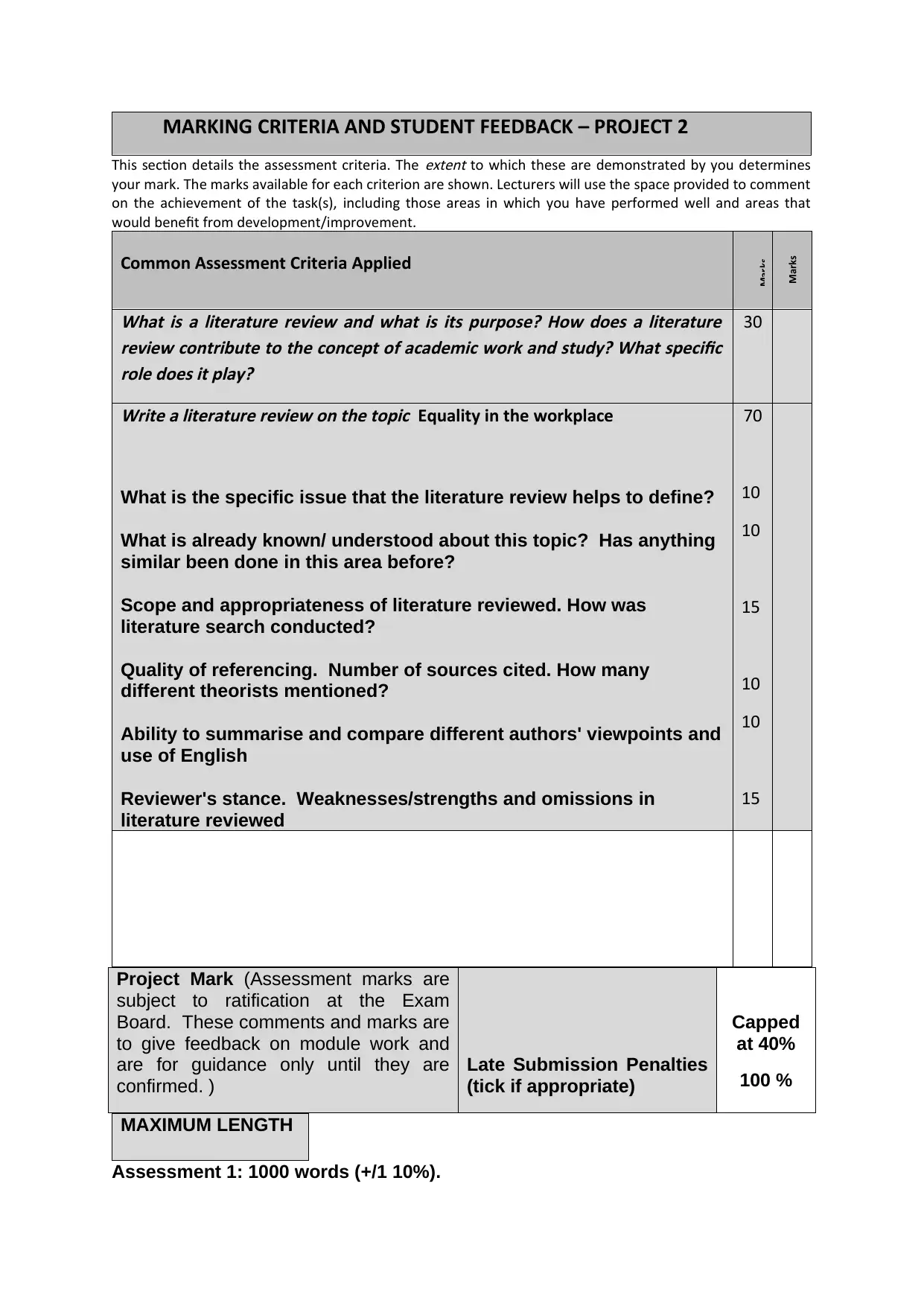
MARKING CRITERIA AND STUDENT FEEDBACK – PROJECT 2
This section details the assessment criteria. The
extent to which these are demonstrated by you determines
your mark. The marks available for each criterion are shown. Lecturers will use the space provided to comment
on the achievement of the task(s), including those areas in which you have performed well and areas that
would benefit from development/improvement.
Common Assessment Criteria Applied
Marks
Marks
What is a literature review and what is its purpose? How does a literature
review contribute to the concept of academic work and study? What specific
role does it play?
30
Write a literature review on the topic Equality in the workplace
What is the specific issue that the literature review helps to define?
What is already known/ understood about this topic? Has anything
similar been done in this area before?
Scope and appropriateness of literature reviewed. How was
literature search conducted?
Quality of referencing. Number of sources cited. How many
different theorists mentioned?
Ability to summarise and compare different authors' viewpoints and
use of English
Reviewer's stance. Weaknesses/strengths and omissions in
literature reviewed
70
10
10
15
10
10
15
Project Mark (Assessment marks are
subject to ratification at the Exam
Board. These comments and marks are
to give feedback on module work and
are for guidance only until they are
confirmed. )
Late Submission Penalties
(tick if appropriate)
Capped
at 40%
100 %
MAXIMUM LENGTH
Assessment 1: 1000 words (+/1 10%).
This section details the assessment criteria. The
extent to which these are demonstrated by you determines
your mark. The marks available for each criterion are shown. Lecturers will use the space provided to comment
on the achievement of the task(s), including those areas in which you have performed well and areas that
would benefit from development/improvement.
Common Assessment Criteria Applied
Marks
Marks
What is a literature review and what is its purpose? How does a literature
review contribute to the concept of academic work and study? What specific
role does it play?
30
Write a literature review on the topic Equality in the workplace
What is the specific issue that the literature review helps to define?
What is already known/ understood about this topic? Has anything
similar been done in this area before?
Scope and appropriateness of literature reviewed. How was
literature search conducted?
Quality of referencing. Number of sources cited. How many
different theorists mentioned?
Ability to summarise and compare different authors' viewpoints and
use of English
Reviewer's stance. Weaknesses/strengths and omissions in
literature reviewed
70
10
10
15
10
10
15
Project Mark (Assessment marks are
subject to ratification at the Exam
Board. These comments and marks are
to give feedback on module work and
are for guidance only until they are
confirmed. )
Late Submission Penalties
(tick if appropriate)
Capped
at 40%
100 %
MAXIMUM LENGTH
Assessment 1: 1000 words (+/1 10%).
Paraphrase This Document
Need a fresh take? Get an instant paraphrase of this document with our AI Paraphraser
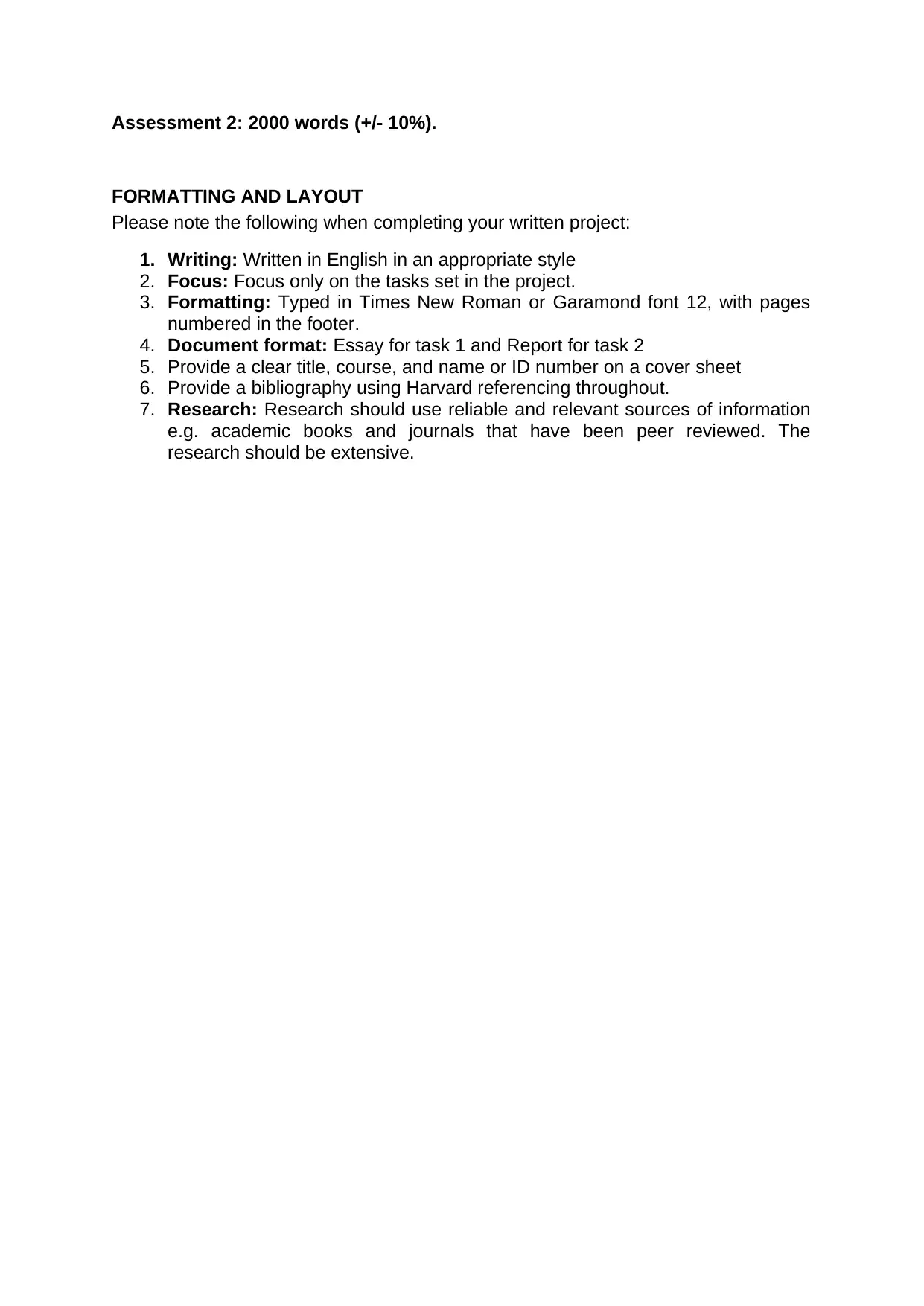
Assessment 2: 2000 words (+/- 10%).
FORMATTING AND LAYOUT
Please note the following when completing your written project:
1. Writing: Written in English in an appropriate style
2. Focus: Focus only on the tasks set in the project.
3. Formatting: Typed in Times New Roman or Garamond font 12, with pages
numbered in the footer.
4. Document format: Essay for task 1 and Report for task 2
5. Provide a clear title, course, and name or ID number on a cover sheet
6. Provide a bibliography using Harvard referencing throughout.
7. Research: Research should use reliable and relevant sources of information
e.g. academic books and journals that have been peer reviewed. The
research should be extensive.
FORMATTING AND LAYOUT
Please note the following when completing your written project:
1. Writing: Written in English in an appropriate style
2. Focus: Focus only on the tasks set in the project.
3. Formatting: Typed in Times New Roman or Garamond font 12, with pages
numbered in the footer.
4. Document format: Essay for task 1 and Report for task 2
5. Provide a clear title, course, and name or ID number on a cover sheet
6. Provide a bibliography using Harvard referencing throughout.
7. Research: Research should use reliable and relevant sources of information
e.g. academic books and journals that have been peer reviewed. The
research should be extensive.
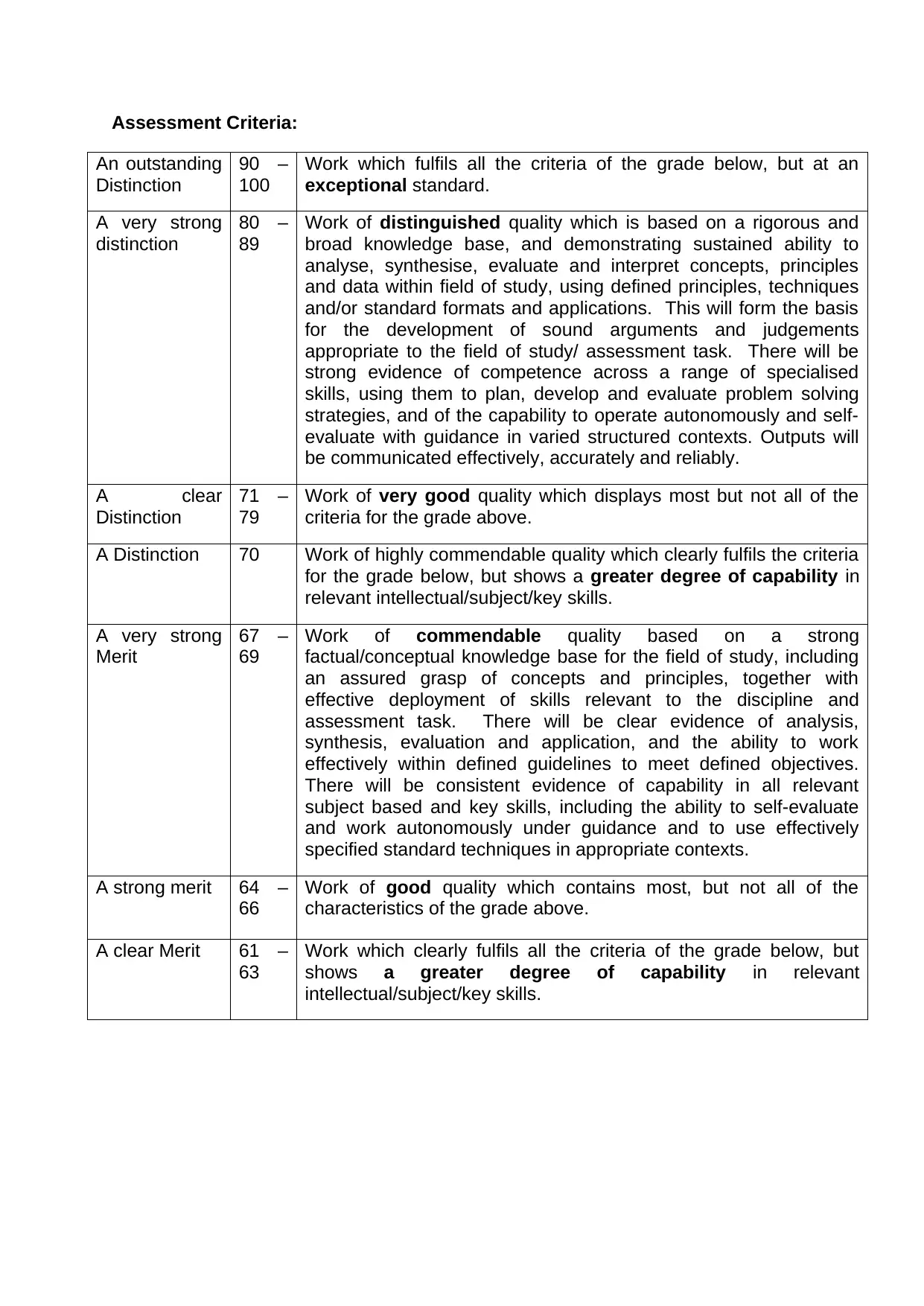
Assessment Criteria:
An outstanding
Distinction
90 –
100
Work which fulfils all the criteria of the grade below, but at an
exceptional standard.
A very strong
distinction
80 –
89
Work of distinguished quality which is based on a rigorous and
broad knowledge base, and demonstrating sustained ability to
analyse, synthesise, evaluate and interpret concepts, principles
and data within field of study, using defined principles, techniques
and/or standard formats and applications. This will form the basis
for the development of sound arguments and judgements
appropriate to the field of study/ assessment task. There will be
strong evidence of competence across a range of specialised
skills, using them to plan, develop and evaluate problem solving
strategies, and of the capability to operate autonomously and self-
evaluate with guidance in varied structured contexts. Outputs will
be communicated effectively, accurately and reliably.
A clear
Distinction
71 –
79
Work of very good quality which displays most but not all of the
criteria for the grade above.
A Distinction 70 Work of highly commendable quality which clearly fulfils the criteria
for the grade below, but shows a greater degree of capability in
relevant intellectual/subject/key skills.
A very strong
Merit
67 –
69
Work of commendable quality based on a strong
factual/conceptual knowledge base for the field of study, including
an assured grasp of concepts and principles, together with
effective deployment of skills relevant to the discipline and
assessment task. There will be clear evidence of analysis,
synthesis, evaluation and application, and the ability to work
effectively within defined guidelines to meet defined objectives.
There will be consistent evidence of capability in all relevant
subject based and key skills, including the ability to self-evaluate
and work autonomously under guidance and to use effectively
specified standard techniques in appropriate contexts.
A strong merit 64 –
66
Work of good quality which contains most, but not all of the
characteristics of the grade above.
A clear Merit 61 –
63
Work which clearly fulfils all the criteria of the grade below, but
shows a greater degree of capability in relevant
intellectual/subject/key skills.
An outstanding
Distinction
90 –
100
Work which fulfils all the criteria of the grade below, but at an
exceptional standard.
A very strong
distinction
80 –
89
Work of distinguished quality which is based on a rigorous and
broad knowledge base, and demonstrating sustained ability to
analyse, synthesise, evaluate and interpret concepts, principles
and data within field of study, using defined principles, techniques
and/or standard formats and applications. This will form the basis
for the development of sound arguments and judgements
appropriate to the field of study/ assessment task. There will be
strong evidence of competence across a range of specialised
skills, using them to plan, develop and evaluate problem solving
strategies, and of the capability to operate autonomously and self-
evaluate with guidance in varied structured contexts. Outputs will
be communicated effectively, accurately and reliably.
A clear
Distinction
71 –
79
Work of very good quality which displays most but not all of the
criteria for the grade above.
A Distinction 70 Work of highly commendable quality which clearly fulfils the criteria
for the grade below, but shows a greater degree of capability in
relevant intellectual/subject/key skills.
A very strong
Merit
67 –
69
Work of commendable quality based on a strong
factual/conceptual knowledge base for the field of study, including
an assured grasp of concepts and principles, together with
effective deployment of skills relevant to the discipline and
assessment task. There will be clear evidence of analysis,
synthesis, evaluation and application, and the ability to work
effectively within defined guidelines to meet defined objectives.
There will be consistent evidence of capability in all relevant
subject based and key skills, including the ability to self-evaluate
and work autonomously under guidance and to use effectively
specified standard techniques in appropriate contexts.
A strong merit 64 –
66
Work of good quality which contains most, but not all of the
characteristics of the grade above.
A clear Merit 61 –
63
Work which clearly fulfils all the criteria of the grade below, but
shows a greater degree of capability in relevant
intellectual/subject/key skills.
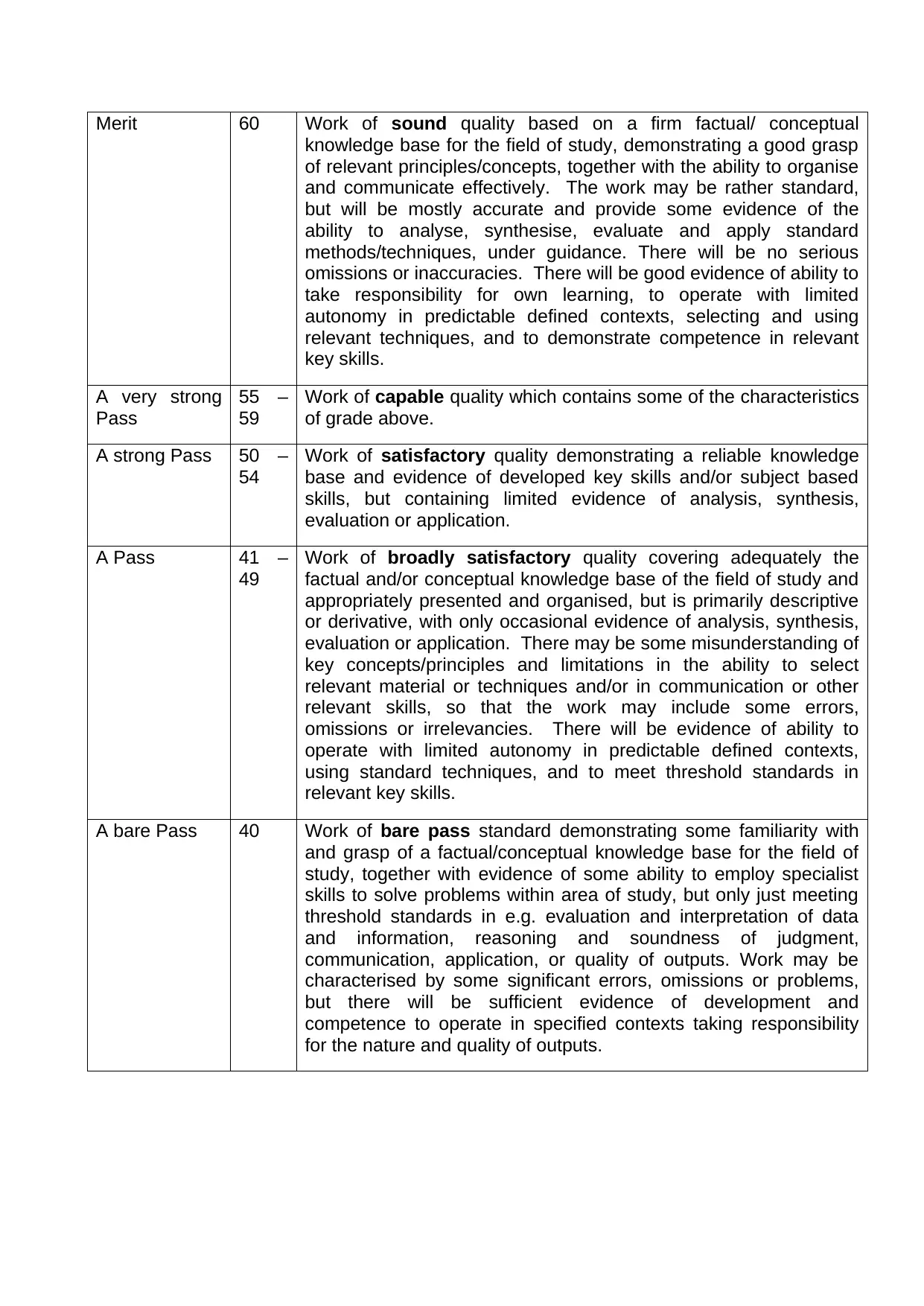
Merit 60 Work of sound quality based on a firm factual/ conceptual
knowledge base for the field of study, demonstrating a good grasp
of relevant principles/concepts, together with the ability to organise
and communicate effectively. The work may be rather standard,
but will be mostly accurate and provide some evidence of the
ability to analyse, synthesise, evaluate and apply standard
methods/techniques, under guidance. There will be no serious
omissions or inaccuracies. There will be good evidence of ability to
take responsibility for own learning, to operate with limited
autonomy in predictable defined contexts, selecting and using
relevant techniques, and to demonstrate competence in relevant
key skills.
A very strong
Pass
55 –
59
Work of capable quality which contains some of the characteristics
of grade above.
A strong Pass 50 –
54
Work of satisfactory quality demonstrating a reliable knowledge
base and evidence of developed key skills and/or subject based
skills, but containing limited evidence of analysis, synthesis,
evaluation or application.
A Pass 41 –
49
Work of broadly satisfactory quality covering adequately the
factual and/or conceptual knowledge base of the field of study and
appropriately presented and organised, but is primarily descriptive
or derivative, with only occasional evidence of analysis, synthesis,
evaluation or application. There may be some misunderstanding of
key concepts/principles and limitations in the ability to select
relevant material or techniques and/or in communication or other
relevant skills, so that the work may include some errors,
omissions or irrelevancies. There will be evidence of ability to
operate with limited autonomy in predictable defined contexts,
using standard techniques, and to meet threshold standards in
relevant key skills.
A bare Pass 40 Work of bare pass standard demonstrating some familiarity with
and grasp of a factual/conceptual knowledge base for the field of
study, together with evidence of some ability to employ specialist
skills to solve problems within area of study, but only just meeting
threshold standards in e.g. evaluation and interpretation of data
and information, reasoning and soundness of judgment,
communication, application, or quality of outputs. Work may be
characterised by some significant errors, omissions or problems,
but there will be sufficient evidence of development and
competence to operate in specified contexts taking responsibility
for the nature and quality of outputs.
knowledge base for the field of study, demonstrating a good grasp
of relevant principles/concepts, together with the ability to organise
and communicate effectively. The work may be rather standard,
but will be mostly accurate and provide some evidence of the
ability to analyse, synthesise, evaluate and apply standard
methods/techniques, under guidance. There will be no serious
omissions or inaccuracies. There will be good evidence of ability to
take responsibility for own learning, to operate with limited
autonomy in predictable defined contexts, selecting and using
relevant techniques, and to demonstrate competence in relevant
key skills.
A very strong
Pass
55 –
59
Work of capable quality which contains some of the characteristics
of grade above.
A strong Pass 50 –
54
Work of satisfactory quality demonstrating a reliable knowledge
base and evidence of developed key skills and/or subject based
skills, but containing limited evidence of analysis, synthesis,
evaluation or application.
A Pass 41 –
49
Work of broadly satisfactory quality covering adequately the
factual and/or conceptual knowledge base of the field of study and
appropriately presented and organised, but is primarily descriptive
or derivative, with only occasional evidence of analysis, synthesis,
evaluation or application. There may be some misunderstanding of
key concepts/principles and limitations in the ability to select
relevant material or techniques and/or in communication or other
relevant skills, so that the work may include some errors,
omissions or irrelevancies. There will be evidence of ability to
operate with limited autonomy in predictable defined contexts,
using standard techniques, and to meet threshold standards in
relevant key skills.
A bare Pass 40 Work of bare pass standard demonstrating some familiarity with
and grasp of a factual/conceptual knowledge base for the field of
study, together with evidence of some ability to employ specialist
skills to solve problems within area of study, but only just meeting
threshold standards in e.g. evaluation and interpretation of data
and information, reasoning and soundness of judgment,
communication, application, or quality of outputs. Work may be
characterised by some significant errors, omissions or problems,
but there will be sufficient evidence of development and
competence to operate in specified contexts taking responsibility
for the nature and quality of outputs.
Secure Best Marks with AI Grader
Need help grading? Try our AI Grader for instant feedback on your assignments.
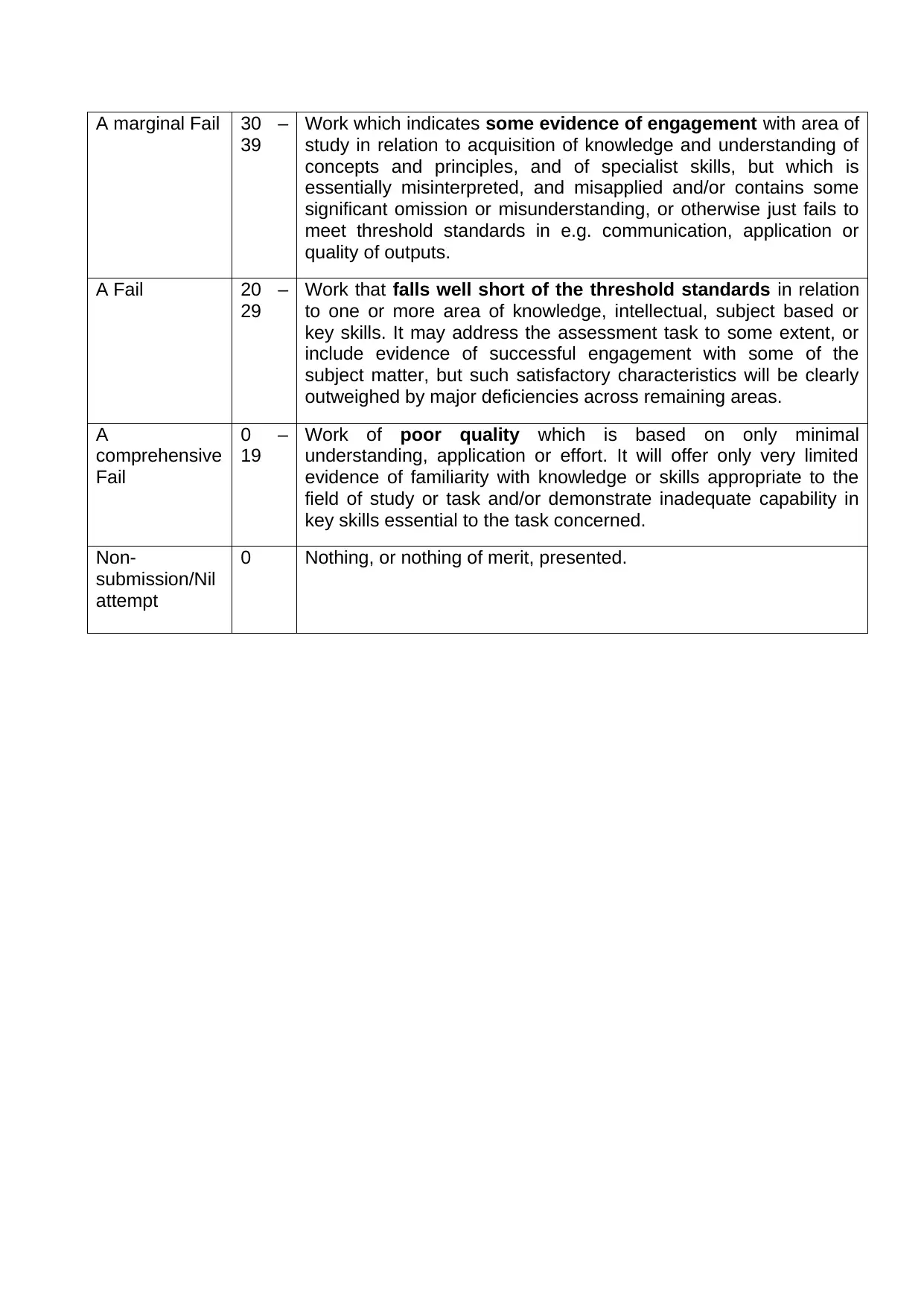
A marginal Fail 30 –
39
Work which indicates some evidence of engagement with area of
study in relation to acquisition of knowledge and understanding of
concepts and principles, and of specialist skills, but which is
essentially misinterpreted, and misapplied and/or contains some
significant omission or misunderstanding, or otherwise just fails to
meet threshold standards in e.g. communication, application or
quality of outputs.
A Fail 20 –
29
Work that falls well short of the threshold standards in relation
to one or more area of knowledge, intellectual, subject based or
key skills. It may address the assessment task to some extent, or
include evidence of successful engagement with some of the
subject matter, but such satisfactory characteristics will be clearly
outweighed by major deficiencies across remaining areas.
A
comprehensive
Fail
0 –
19
Work of poor quality which is based on only minimal
understanding, application or effort. It will offer only very limited
evidence of familiarity with knowledge or skills appropriate to the
field of study or task and/or demonstrate inadequate capability in
key skills essential to the task concerned.
Non-
submission/Nil
attempt
0 Nothing, or nothing of merit, presented.
39
Work which indicates some evidence of engagement with area of
study in relation to acquisition of knowledge and understanding of
concepts and principles, and of specialist skills, but which is
essentially misinterpreted, and misapplied and/or contains some
significant omission or misunderstanding, or otherwise just fails to
meet threshold standards in e.g. communication, application or
quality of outputs.
A Fail 20 –
29
Work that falls well short of the threshold standards in relation
to one or more area of knowledge, intellectual, subject based or
key skills. It may address the assessment task to some extent, or
include evidence of successful engagement with some of the
subject matter, but such satisfactory characteristics will be clearly
outweighed by major deficiencies across remaining areas.
A
comprehensive
Fail
0 –
19
Work of poor quality which is based on only minimal
understanding, application or effort. It will offer only very limited
evidence of familiarity with knowledge or skills appropriate to the
field of study or task and/or demonstrate inadequate capability in
key skills essential to the task concerned.
Non-
submission/Nil
attempt
0 Nothing, or nothing of merit, presented.

1 out of 12
Related Documents
Your All-in-One AI-Powered Toolkit for Academic Success.
+13062052269
info@desklib.com
Available 24*7 on WhatsApp / Email
![[object Object]](/_next/static/media/star-bottom.7253800d.svg)
Unlock your academic potential
© 2024 | Zucol Services PVT LTD | All rights reserved.





